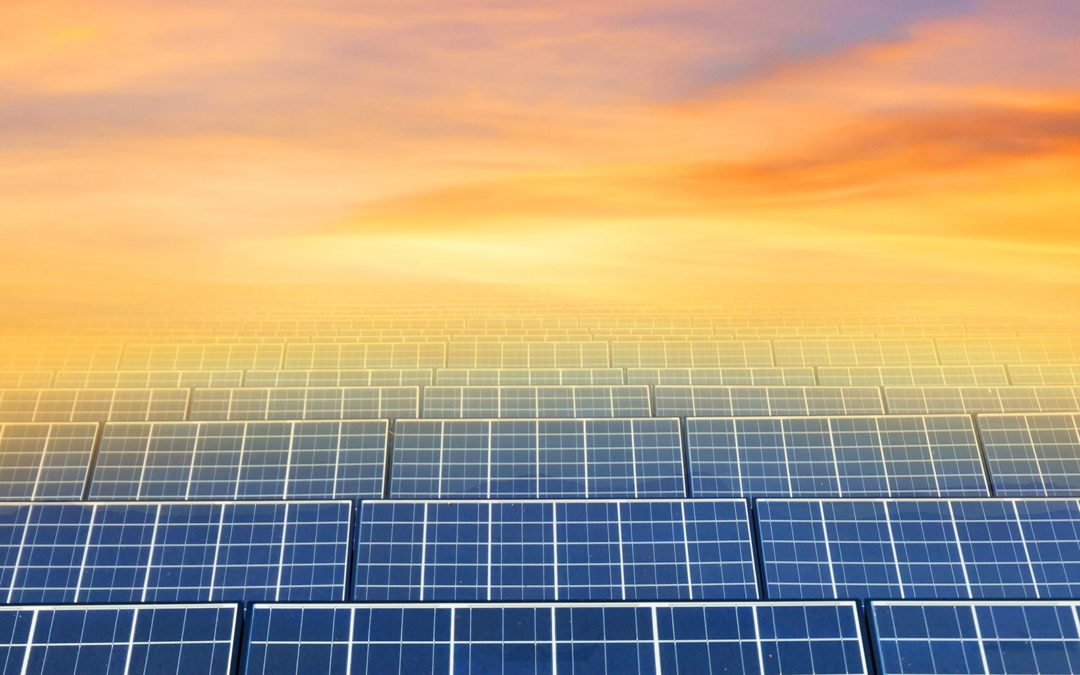
by Jim Boullion | Dec 28, 2020 | Energy Storage, Renewables, Solar, Wind
On Sunday December 27th, President Trump signed a $1.4 trillion omnibus spending bill that includes support for clean energy programs and the extension of two important renewable energy tax credits. The law provides support for the advancement of solar, wind, energy storage, research and development, and energy efficiency.
The renewable electricity Production Tax Credit (PTC) and the Investment Tax Credit (ITC) have been instrumental to advancing renewable energy in the United States and the extension included in the recent omnibus bill will help ensure clean energy’s continued growth. The tax credits for wind and solar, in particular, are expected to spur vital economic investment.
Catherine Morehouse of Utility Dive noted that the “legislation will extend the PTC and ITC for land-based wind for one year at 60% of the project’s full value … and give offshore wind projects for the first time a 30% ITC for projects that began construction starting January 1, 2017 through December 31, 2025.”
Abby Hopper, President and CEO of the Solar Energy Industry Association (SEIA), sent a summary of key solar and energy storage provisions to local SEIA Chapters like RENEW Wisconsin. Below are highlights from her report:
Federal Tax Bill 2020 – Key Solar And Storage Provisions
-
- Federal Tax Credits Extended: The solar investment tax credit (ITC) will remain at 26% for projects that begin construction in 2021 and 2022, step down to 22% in 2023, and down to 10% in 2024 for commercial projects while the residential credit ends completely. Companies beginning construction on projects in 2021 will still have a four-year period to place their projects in service to take advantage of the ITC, with the statutory deadline for projects placed in service reset to before January 1, 2026.
- Reduce Barriers to Solar Adoption: $35 million appropriation for the Department of Energy (DOE), directing the Solar Energy Technologies Office to “reduce market barriers…to the adoption of solar energy technologies,” including “the development of best practices, models, and voluntary streamlined processes for local siting and permitting of distributed solar energy systems to reduce costs.”
- Increase Funding for Solar Research: Boosts annual spending targets to $300 million per year through 2025 for DOE programs that improve solar PV energy efficiency and cost-effectiveness, increase manufacturing and recycling of solar panels, and fund programs to integrate solar power into the grid;
- Invest in Energy Storage Research: Directs $100 million per year through 2025 to a newly created Energy Storage System Research, Development, and Deployment Program at DOE, aimed at R&D to improve technologies ranging from distributed batteries and control systems for grid integration, long-duration storage technologies such as pumped hydro and compressed-air energy storage.
Learn more about the details of the new law at GreenTechMedia which provides deeper analysis of the solar and wind tax credit impacts.
RENEW Wisconsin is thrilled to see this package come together and get signed into law. This new investment in clean energy is welcome news for Wisconsin’s renewable energy workers and has the potential to drive economic activity and clean energy investment in the coming years.
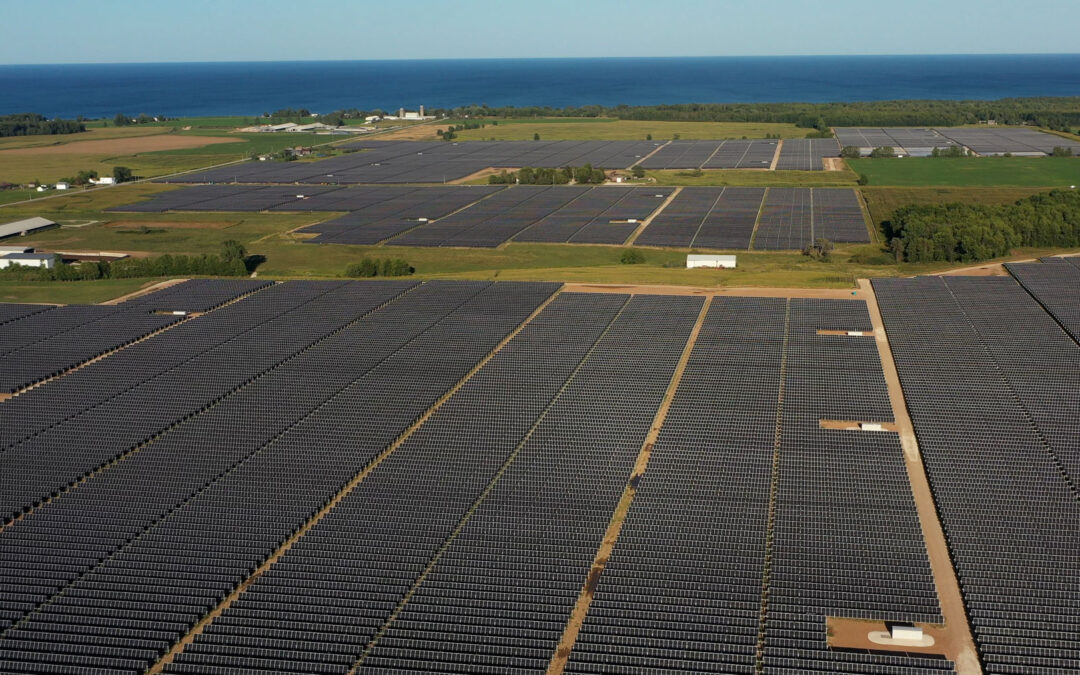
by Michael Vickerman | Nov 15, 2020 | Public Service Commission, Renewables, Solar, Utilities, Utility Scale
The Two Creeks Solar Park, located in Manitowoc County, was energized last week, becoming the state’s largest generating station powered by the sun. Developed by Florida-based NextEra Energy, Two Creeks is jointly owned by two Wisconsin electric utilities: Wisconsin Public Service Corporation (WPS) and Madison Gas and Electric (MGE). WPS owns and operates a 100 megawatt (MW) share of the 150 MW power plant, while MGE has the remaining 50 MW share.
Located next to the Point Beach Nuclear Plant, Two Creeks effectively doubles the amount of solar generating capacity in Wisconsin to 300 MW, and will, over the next six months, produce more electricity than the combined output from all other existing solar systems in Wisconsin. Expected to produce more than 300,000,000 megawatt-hours a year, Two Creeks will generate about one-half of one percent of the state’s overall supply of electricity, which is the equivalent of what 33,000 residences consume annually.
Along with the 300 MW Badger Hollow Solar Farm in Iowa County, Two Creeks received approval from the Public Service Commission (PSC) in April 2019. These two were the pioneering solar farm proposals that navigated through the PSC’s power plant siting process and won approval from the agency. At the same meeting, the PSC granted a joint request from WPS and MGE to acquire Two Creeks.
Since then, the PSC has given the green light to two more solar farms totaling 249 MW in capacity, including NextEra Energy’s 100 MW Point Beach Solar Farm next door to Two Creeks. Point Beach Solar is under construction and should be completed in the fall of 2021.
Construction work on Two Creeks commenced on August 2019, kicked off with a groundbreaking ceremony that drew Gov. Tony Evers and the two utility ceos. Governor Evers’ appearance came less than a week after he issued Executive Order 38, articulating a goal of “ensuring all electricity consumed within the State of Wisconsin is 100% carbon-free by 2050.”
Building Two Creeks was no small undertaking. It involved punching thousands of posts into the ground to support horizontal tracking systems spreading across 800 acres of relatively flat terrain. Mounted on these rotating poles are more than 500,000 panels that follow the sun as it crosses the sky going east to west. Between the first rays of sunlight and the last ones before sunset, these panels soak in the sunshine and convert it to electricity.
A plant like Two Creeks will begin displacing higher-cost power at the moment it is energized, and these savings will grow significantly over the course of its 30-to-50-year life. True, the utilities will need to recover the cost of building the solar farm, somewhere in the vicinity of $195 million. But the savings utilities expect to reap from avoided fossil fuel purchases and pollution control expenditures will more than outweigh their investment in a zero-carbon generation source. Seen in this light, large-scale solar is indisputably the most cost-effective supply option that an electric utility can pursue going forward.
The benefits from Two Creeks extend beyond ratepayer savings. Manitowoc County and the Town of Two Creeks, the jurisdictions hosting the solar farm, expect to reap a combined $600,000 in local aids each year while the project remains in service. That number grows to $18,000,000 over the course of 30 years, which is the projected minimum lifespan of Two Creeks.
Solar is a noncombustible energy resource that does not emit any gaseous emissions or particulates when converted to electricity. Deploying solar at the scale of Two Creeks will capture significant public health and air quality benefits by avoiding emissions that are associated with conventional fossil generation plants. In another PSC proceeding involving a 15O MW solar farm in eastern Wisconsin, the developer anticipates annual emissions reductions in the following categories of pollutants: (1) nitrogen oxide (NOx) emissions by 195,000 pounds; (2) methane (CH4) by 20,000 pounds; (3) nitrous oxide (N2O) by 5,000 pounds; and (4) carbon dioxide (CO2) by 405 million pounds.
Decarbonizing the state’s fleet of power plants is also a job creation strategy. The PSC estimates that somewhere between 200 and 300 jobs were created during the project’s construction window. It’s quite likely that many of the workers involved in the building of Two Creeks are now hard at work constructing the adjoining Point Beach solar farm.
In the annals of Wisconsin electric utility history, Two Creeks represents a noteworthy milestone, as the first solar farm to clear the PSC’s power plant review process and become a valuable addition to the state’s portfolio of power plants. And it took only 18+ months from the crossing of the regulatory finish line for Two Creeks to start sending power into the grid.
Two Creeks can also be viewed as the lead entry in a parade of large solar farms seeking to cross the same regulatory finish line and proceed to construction and completion. Looking out over the next 12 months, the PSC will review and make decisions on six solar farm applications totaling 1,150 MW (see table below).
| Project name |
Developer |
County |
Capacity
(in MW) |
Anticipated decision date |
| Paris |
Invenergy |
Kenosha |
200 |
11/2020 |
| Wood County |
Savion |
Wood |
150 |
12/2020 |
| Grant County |
NextEra Energy |
Grant |
200 |
4/2021 |
| Onion River |
Ranger Power |
Sheboygan |
150 |
5/2021 |
| Darien |
Invenergy |
Walworth/
Rock |
250 |
7/2021 |
| Apple River |
National Grid |
Polk |
100 |
9/2021 |
| Springfield |
National Grid |
Dodge |
100 |
9/2021 |
Within that same 12-month window, we expect two more PSC-approved solar farms—Badger Hollow I (150 MW) and Point Beach (100 MW) to cross the finish line and begin generating electricity.
What we’re seeing here is the emergence of a new resource paradigm that is ushering in a major wave of public works construction across the state. As this transition unfolds, solar power will become widely recognized as a linchpin in the state’s economy, extending through this decade and beyond.
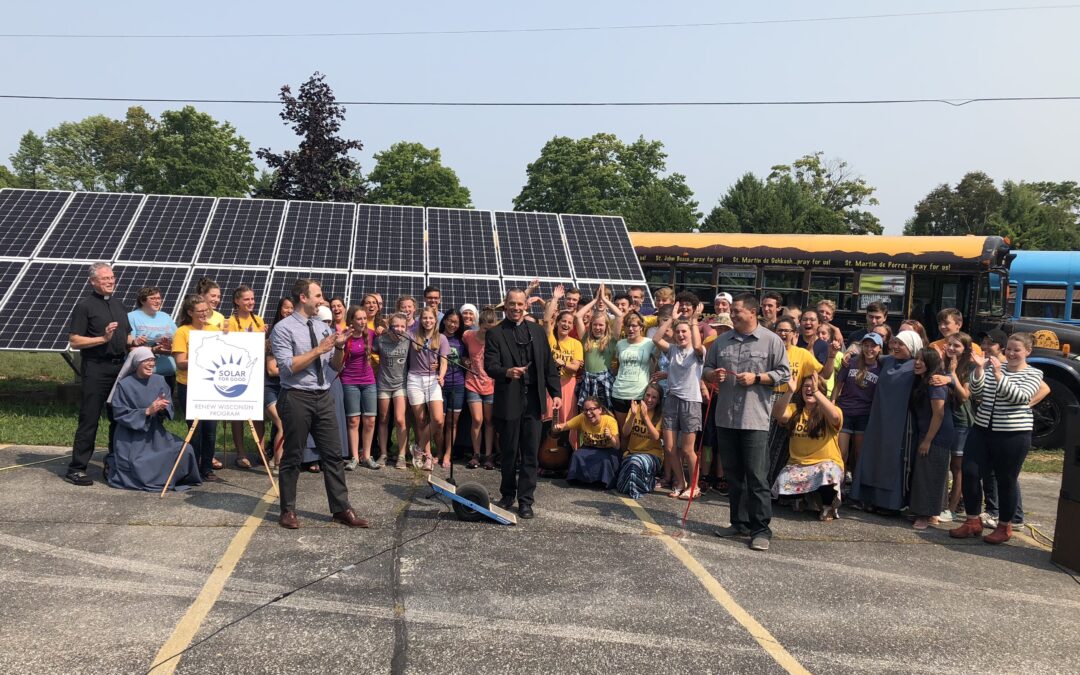
by Sam Dunaiski | Oct 29, 2020 | Community, Local Initiatives, Renewables, Solar, Solar for Good, Sustainable Business
RENEW Wisconsin’s Solar for Good program has awarded over $190,000 in cash grants and materials to Wisconsin nonprofits for installing on-site solar energy systems. Seventeen organizations will install 719 kilowatts of clean, renewable electricity leading to nearly $1.4 million in renewable energy investments in Wisconsin.
The following organizations have been offered Fall 2020 Solar for Good grants to install new solar electric systems:
All Saints Lutheran Church, house of worship, Fitchburg.
Boys and Girls Club of Dane County, after-school youth programming, Madison.
Community Clothes Closet, free clothing provider, Menasha.
Couleecap Inc, poverty alleviation, Westby.
Ezekiel Lutheran Church, house of worship, River Falls.
Friends of Sauk County Fairgrounds, historic preservation, Baraboo.
Grace Evangelical Free Church, house of worship, Viroqua.
Habitat for Humanity of Dane County, affordable housing provider, Madison.
Habitat for Humanity Restore, affordable housing support, Beaver Dam.
Just One More Ministry, food pantry, Glendale.
Milwaukee Habitat for Humanity Restore, affordable housing support, Greenfield.
Plymouth Congregational United Church of Christ, house of worship, Madison.
The BRICK Ministries, poverty alleviation and food pantry, Ashland.
Walnut Way Conservation Corps, community conservation organization, Milwaukee.
Yerkes Future Foundation, education and historic preservation, Williams Bay.
Two organizations have asked to remain anonymous at this time.
This round of Solar for Good grants features a diverse group of organizations from across Wisconsin. The Boys and Girls Club of Dane County will install over 250 panels at their Madison-based facility and plan to demonstrate the benefits of solar energy to the young people they serve. An 11-kilowatt array will be installed at the BRICK Ministries in Ashland with the help of donated solar panels from One Energy Renewables, a large-scale solar developer. And a 60-kilowatt array is planned at the famous Yerkes Observatory in Williams Bay, home of the world’s largest refracting telescope used for astronomical research.
“The grant and the installation of solar panels underscores the ongoing value of Yerkes Observatory as a place for scientific discovery and education,” stated Dianna Colman of Yerkes Future Foundation. “Students and visitors will experience firsthand the impact of solar power…even on a building dating back to 1897.”
In addition to the Couillard Solar Foundation, Solar for Good’s founding funder, this cycle of grants also received backing from the Array it Forward initiative at First Unitarian Society in Madison. The First Unitarian Society won a Solar for Good grant in 2018 and wanted to share the benefits they received from their solar array with other nonprofits across Wisconsin. Array it Forward is made possible through donations solicited from their congregation and the community.
“Solar for Good shares our values and priorities for stabilizing our climate and speeding our transition to renewable energy,” said Carol Phelps, a contributing donor to Array it Forward. “This will make life better for the children of the world…when people unite to tackle climate change, there is great hope for the future.”
The 17 nonprofit organizations are a part of Solar for Good’s 7th round of funding. Since its inception in 2017, Solar for Good has offered solar grants to 96 Wisconsin-based nonprofits.
When each of the solar projects are energized, these nonprofits will have added over 4 megawatts of clean, renewable energy to Wisconsin’s electric mix, enough to power approximately 900 homes. Solar for Good projects will represent a total of $9.2 million of private investments in Wisconsin renewable energy over the past three years.
About Solar for Good RENEW Wisconsin’s Solar for Good initiative fosters the expansion of solar power among mission-based nonprofits and houses of worship in Wisconsin. Through a generous partnership with Couillard Solar Foundation and Array it Forward, RENEW Wisconsin awards grants and solar panels to nonprofit organizations, helping them switch to clean, renewable, solar energy.
About RENEW Wisconsin RENEW Wisconsin is a nonprofit organization which promotes renewable energy in Wisconsin. We work on policies and programs that support solar power, wind power, biogas, local hydropower, geothermal energy, and electric vehicles. More information on RENEW’s website: www.renewwisconsin.org.
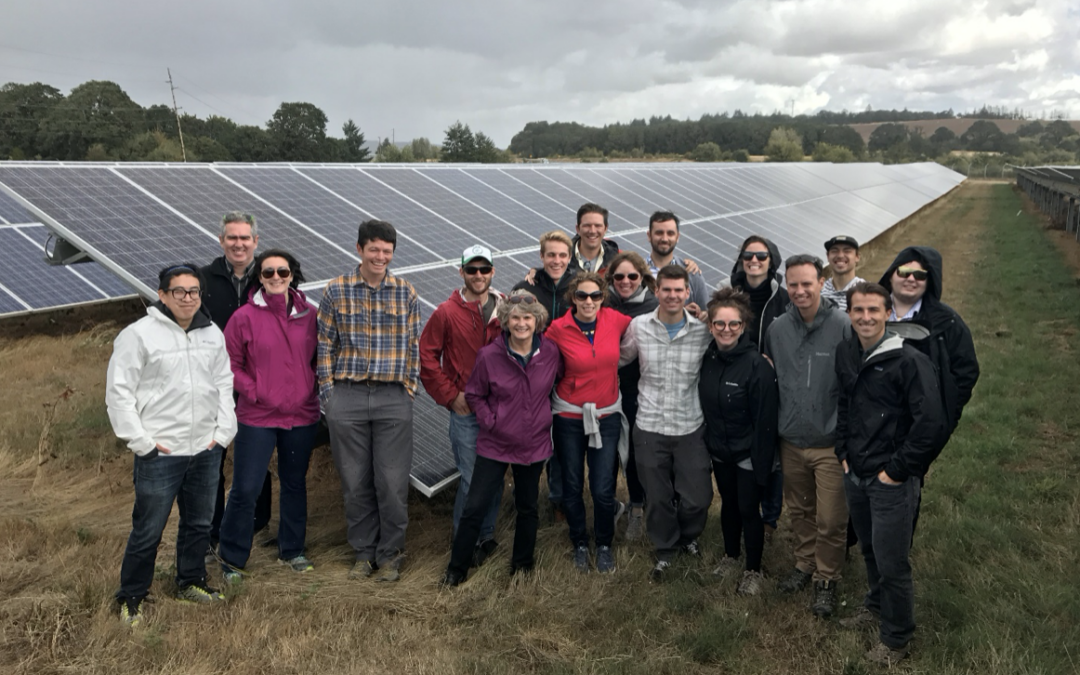
by Guest Blog | Aug 5, 2020 | Community, Renewables, Solar
Submitted by Bill Bailey of Cheq Bay Renewables
Two Ashland, Wisconsin nonprofits are installing solar photovoltaic systems on their facilities. The nonprofits are household names in the Chequamegon Bay area of western Lake Superior – the New Day Advocacy Center and The BRICK Ministries.
New Day Advocacy Center provides free and confidential domestic violence and sexual assault victim services, including shelter and other crisis intervention services. They also provide community prevention education to culture respect and lasting change in community behavior – No More Abuse!
The BRICK’s mission is to compassionately help people in need. They are best known for their Food Shelf Program, but also provide emergency financial resources and referrals with a focus to keep people in their homes through their Benevolence Program
Both organizations have considered solar installations in the past to reduce utility expenses and to generate clean energy. But as each nonprofit had roofs which needed repair, and had purchased or recently moved into newly renovated facilities, they were both financially strained. The solar would have to wait. That was until Eric Udelhofen called from OneEnergy Renewables, a community and utility scale solar project developer based in Seattle, Washington with a satellite office in Madison.
OneEnergy had 35 high-quality, modern solar modules they wanted to donate to a worthy Ashland nonprofit. OneEnergy was the solar developer on the recently constructed 1-megawatt Xcel Energy community solar garden in Ashland. The modules were “bones,” extra parts, left over from purchasing or shipping in bulk quantities, and OneEnergy wanted something good to come from their surplus.
Solar modules represent roughly 15% of the cost of a small solar project. The other 85% is comprised of inverters, racking, miscellaneous additional materials and labor. Jolma Electric of Ashland, who was also involved in the installation of Ashland’s community solar project, joined the project agreeing to perform its installation services “at cost,” and the total project cost was reduced by 22%. Then C&S Design & Engineering, also from Ashland, reduced their engineering cost by 50%, further lowering the total installation price.
Additional funding was needed to cover the remaining balance of the installation. The New Day Board was the first of the two projects to vote to move forward with raising the remaining funds. A GoFundMe site was set up and $6,500 was raised in two weeks. In addition, $3,400 of private checks were received designated for the solar installation. Of the nearly $10,000 of cash donated to the New Day rooftop solar project, OneEnergy employees donated $6,000.
There is another story here. At the core of OneEnergy’s business model is a commitment to serve the communities in which they operate, along with a strident belief that the transition to clean energy will help create a more sustainable and equitable global economy. Not only did the corporation donate the solar modules, but employees stood behind this commitment and donated their personal cash. The status quo of corporate America as an entity has become isolated from their communities. OneEnergy, as well as Jolma Electric and C&S Design and Engineering, are demonstrating an alternative approach, modeling a more enlightened view about the role of companies in society and a commitment to be the change that they wish to see in the world.
So New Day’s project is off and running and now The BRICK has begun its fundraising campaign. An awning style installation was designed by Jolma Electric and C&S Design & Engineering. The donated modules will fill half the south façade of the facility with opportunity to fill the remainder if or when funds allow. The full project would cost $31,990 of which $20,490 has already been raised. A GoFundMe site has been set up for The BRICK to fund the remaining $11,500. If you can help go to: https://bit.ly/3k0IeLm to donate.
During this time of COVID-19, it is encouraging to see that community-building defeats fear, love overcomes hatred, and clean energy offsets fossil fuels. With the support of this community, these two nonprofits, New Day Advocacy Center and The BRICK, are choosing the alternative path, the “culture of service.”
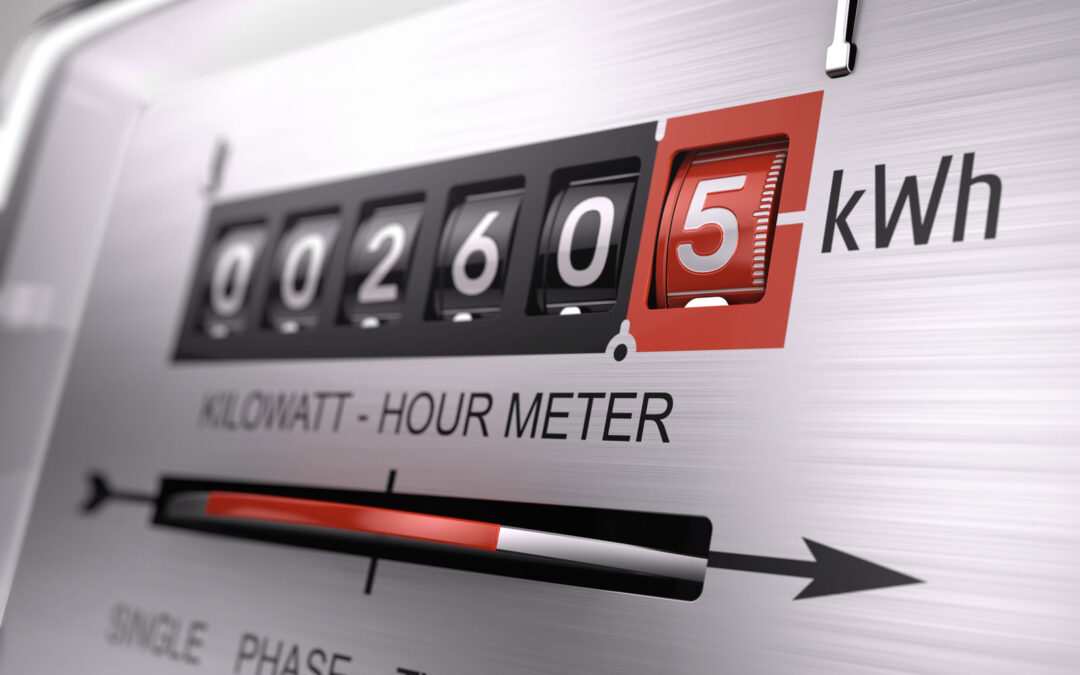
by Heather Allen | Jul 21, 2020 | Advocacy, Policy, RENEW Wisconsin, Renewables, Solar, Utilities
Last week the Federal Energy Regulatory Commission (FERC) dismissed a challenge to state control of net metering. The unanimous decision made on Thursday, July 16, 2020 was great news for RENEW Wisconsin and our members. Homeowners, business and manufacturers that generate their own solar energy can now breathe easy, knowing that the oversight for net metering policy remains in the hands of Wisconsin’s own Public Service Commission.
The New England Ratepayers Association (“NERA”) had petitioned the FERC to take control over net metering policy for the entire country. If the petition were granted, states would have lost the ability to set policy on solar electricity generated by utility customers. The challenge to state control of net metering, the policy that enables energy producers to get bill credit for the extra energy they push back on to the grid, threatened the solar investments of thousands of families and businesses in Wisconsin.
RENEW joined dozens of other clean energy advocacy organizations in a petition to dismiss the issue and encouraged Wisconsin’s political leadership to get involved. Many elected officials from around the country joined in the fight to protect net metering including Wisconsin’s own, Attorney General Josh Kaul.
Check out the background on this story and how RENEW fought to protect Wisconsinites generating clean energy on their homes and businesses.

by Jim Boullion | Jun 22, 2020 | Action Alert, Advocacy, Community, Electric Vehicles, Policy, Renewables, Solar
In October of 2019, Governor Tony Evers announced the formation of the Wisconsin Climate Change Task Force. Led by Lt. Governor Barnes, this bi-partisan group represents lawmakers, utilities, agriculture, environmental groups, health officials, and tribes with a goal of developing strategies to help Wisconsin reduce the effects of climate change and reach 100% carbon free electricity generation by 2050.
The Climate Change Task Force has been collecting ideas from various organizations and has worked hard to identify dozens of items that could be implemented. The next step is to hear from Wisconsin residents. The Governor, Lt. Governor, and Climate Change Task Force need your input and support to find the best path forward.
RENEW has identified three key issues that we feel would have the greatest impact and best chances for success. Join this important effort by signing your name in support of these initiatives!
Third Party Financing
Wisconsin should affirm the legality of third party financed distributed energy resources in order to provide equitable access to renewable energy benefits.
Electric Vehicle Infrastructure
Wisconsin should develop a comprehensive plan for transportation electrification.
Expand Focus on Energy
Wisconsin should facilitate the installation of more renewable energy and energy efficiency measures by expanding the Focus on Energy program.
If you have other ideas and would like to contribute more to the Climate Change Task Force, consider taking the following actions:
Provide written comments to the Task Force. Comments must be submitted by July 15th.
Provide live comments at the end of one of the remaining Task Force Subcommittee meetings.
Provide live comments during the Virtual Public Listening Sessions, which will be held on June 23, June 27, July 7, July 9 and July 15.
In August, the Task Force will review all of the comments they receive, and make their recommendations for the final report in September. The report is scheduled to be released on October 31, 2020.
If you have any questions, need more information, or would like help preparing for live comments, please contact Jim Boullion, RENEW’s Director of Government Affairs at jim@renewwisconsin.org or call at (608) 695-7004.
RENEW Wisconsin is a proud partner of Rise Up Midwest, a coalition effort led by MREA promoting renewable energy investment and grid modernization. Rise Up Midwest supports this petition and has highlighted their own policy priorities and programs to advance their mission.






